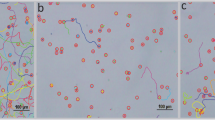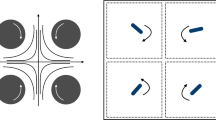Abstract
Swimming is a fundamental trait of many protists and optimizes growth and survival. We present an easy to use set-up for filming algal cells using Apocalathium aciculiferum and Borghiella dodgei as case studies; both dinoflagellates are model organisms of psychrophilic dinoflagellates. We filmed at low temperature (4.5°C) using a digital camera directly connected to a microscope and used open-source software to track their movement. We encountered several technical issues that were solved by using specific software settings (scaling, grey scale of images, restrictive particle recognition), and thus we obtained unbiased speed estimates. Borghiella dodgei showed a faster (minimum = 80, maximum = 255, median = 141 µm s−1) swimming speed than A. aciculiferum (minimum = 29, maximum = 134, median = 85 µm s−1). We linked differences in swimming speed to the dinoflagellates’ environmental niche, and suggested that B. dodgei is more adapted to turbulent spring conditions than A. aciculiferum, occurring under ice. The use of a generic digital camera and open-source software makes filming and tracking of plankton movement very affordable. We provided code and detailed instructions to disseminate this type of movement analysis of plankton.

Similar content being viewed by others
References
Andersen, R. A., S. L. Morton & J. P. Sexton, 1997. Provasoli Guillard National Center for culture of marine phytoplankton, list of strains. Journal of Phycology 33: 1–7.
Ault, T. R., 2000. Vertical migration by the marine dinoflagellate Prorocentrum triestinum maximises photosynthetic yield. Oecologia 125: 466–475.
Baek, S. H., S. Shimode, K. Shin, M. S. Han & T. Kikuchi, 2009. Growth of dinoflagellates, Ceratium furca and Ceratium fusus in Sagami Bay, Japan: the role of vertical migration and cell division. Harmful Algae 8: 843–856.
Baek, S. H., J. S. Ki, T. Katano, K. You, B. S. Park, H. H. Shin, K. Shin, Y. O. Kim & M. S. Han, 2011. Dense winter bloom of the dinoflagellate Heterocapsa triquetra below the thick surface ice of brackish Lake Shihwa, Korea. Phycological Research 59: 273–285.
Berdalet, E., F. Peters, V. L. Koumandou, C. Roldan, O. Guadayol & M. Estrada, 2007. Species-specific physiological response of dinoflagellates to quantified small-scale turbulence. Journal of Phycology 43: 965–977.
Bruijning, M., M. D. Visser, C. A. Hallmann & E. Jongejans, 2018. trackdem: automated particle tracking to obtain population counts and size distributions from videos in R. Methods in Ecology and Evolution 9: 965–973.
Butterwick, C., S. I. Heaney & J. F. Talling, 2005. Diversity in the influence of temperature on the growth rates of freshwater algae, and its ecological relevance. Freshwater Biology 50: 291–300.
Calliari, D., F. Corradini & G. Flaim, 2004. Dinoflagellate diversity in Lake Tovel. Studi Trentini di Scienze Naturali Acta Biologica 81: 351–357.
Cellamare, M., A. M. Lancon, M. Leitão, L. Cerasino, U. Obertegger & G. Flaim, 2016. Phytoplankton functional response to spatial and temporal differences in a cold and oligotrophic lake. Hydrobiologia 764: 199–209.
Colangeli, P., A. Cieplinski & U. Obertegger, 2016. Filming of zooplankton: a case study of rotifer males and Daphnia magna. Journal of Limnology 75: 204–209.
Colangeli, P., U. E. Schlägel, U. Obertegger, J. S. Petermann, R. Tiedemann & G. Weithoff, 2019. Negative phototactic response to UVR in three cosmopolitan rotifers: a video analysis approach. Hydrobiologia 844: 1–12.
Flaim, G., Ø. Moestrup, G. Hansen & M. D’Andrea, 2006. From Glenodinium to Tovellia. Studi Trentini Scienze Naturali 81: 447–457.
Flaim, G., E. Rott, R. Frassanito, G. Guella & U. Obertegger, 2010. Eco-fingerprinting of the dinoflagellate Borghiella dodgei: experimental evidence of a specific environmental niche. Hydrobiologia 639: 85–98.
Flaim, G., U. Obertegger & G. Guella, 2012. Changes in galactolipid composition of the cold freshwater dinoflagellate Borghiella dodgei in response to temperature. Hydrobiologia 698: 285–293.
Flaim, G., U. Obertegger, A. Anesi & G. Guella, 2014. Temperature-induced changes in lipid biomarkers and mycosporine-like amino acids in the psychrophilic dinoflagellate Peridinium aciculiferum. Freshwater Biology 59: 985–997.
Fenchel, T., 2001. How dinoflagellates swim. Protist 152: 329–338.
Hansen, G. & G. Flaim, 2007. Dinoflagellates of the Trentino province, Italy. Journal of Limnology 66: 107–141.
Hall, N. S. & H. W. Paerl, 2011. Vertical migration patterns of phytoflagellates in relation to light and nutrient availability in a shallow microtidal estuary. Marine Ecology Progress Series 425: 1–19.
Jang, S. H., H. J. Jeong, Ø. Moestrup, N. S. Kang, S. Y. Lee, K. H. Lee, M. J. Lee & J. H. Noh, 2015. Morphological, molecular and ecophysiological characterization of the phototrophic dinoflagellate Biecheleriopsis adriatica from Korean coastal waters. European Journal of Phycology 50: 301–317.
Kamykowski, D. & S. A. McCollum, 1986. The temperature acclimated swimming speed of selected marine dinoflagellates. Journal of Plankton Research 8: 275–287.
Kamykowski, D., R. E. Reed & G. J. Kirkpatrick, 1992. Comparison of sinking velocity, swimming velocity, rotation and path characteristics among six marine dinoflagellate species. Marine Biology 113: 319–328.
Kuhn, M. 2019. Contributions from J. Wing, S. Weston, A. Williams, C. Keefer, A. Engelhardt, T. Cooper, Z. Mayer, B. Kenkel, the R Core Team, M. Benesty, R. Lescarbeau, A. Ziem, L. Scrucca, Y. Tang, C. Candan and T. Hunt. caret: Classification and Regression Training. R package version 6.0-84. https://CRAN.R-project.org/package=caret.
Levandowsky, M. & P. J. Kaneta, 1987. Behaviour in dinoflagellates. The Biology of Dinoflagellates 151: 360–397.
Lim, A. S., H. J. Jeong, T. Y. Jang, S. H. Jang & P. J. Franks, 2014. Inhibition of growth rate and swimming speed of the harmful dinoflagellate Cochlodinium polykrikoides by diatoms: implications for red tide formation. Harmful Algae 37: 53–61.
Margalef, R., 1978. Life-forms of phytoplankton as survival alternatives in an unstable environment. Oceanologica Acta 1: 493–509.
McLean, D. J. & S. M. A. Volponi, 2018. trajr: an R package for characterisation of animal trajectories. Ethology 124: 440–448.
Moestrup, Ø. & A. Calado, 2018. Süßwasserflora von Mitteleuropa, Bd. 6 - Freshwater Flora of Central Europe, Vol. 6: Dinophyceae. Springer.
Nielsen, L. T. & T. Kiørboe, 2015. Feeding currents facilitate a mixotrophic way of life. The ISME Journal 9: 2117–2127.
Obertegger, U., F. Camin, G. Guella & G. Flaim, 2011. Adaptation of a psychrophilic freshwater dinoflagellate to ultraviolet radiation. Journal of Phycology 47: 811–820.
Obertegger, U., A. Cieplinski, M. Raatz & P. Colangeli, 2018. Switching between swimming states in rotifers: case study Keratella cochlearis. Marine and Freshwater Behaviour and Physiology 51: 159–173.
Persson, A., B. C. Smith, G. H. Wikfors & J. H. Alix, 2013. Differences in swimming pattern between life cycle stages of the toxic dinoflagellate Alexandrium fundyense. Harmful Algae 21: 36–43.
Powers, S. M. & S. E. Hampton, 2019. Open science, reproducibility, and transparency in ecology. Ecological Applications 29: e01822.
Regel, R. H., J. D. Brookes & G. G. Ganf, 2004. Vertical migration, entrainment and photosynthesis of the freshwater dinoflagellate Peridinium cinctum in a shallow urban lake. Journal of Plankton Research 26: 143–157.
Reynolds, C. S., 1998. The state of freshwater ecology. Freshwater Biology 39: 741–753.
Rengefors, K. & C. Legrand, 2001. Toxicity in Peridinium aciculiferum: an adaptive strategy to outcompete other winter phytoplankton? Limnology & Oceanography 46: 1990–1997.
Rengefors, K., 1998. Seasonal succession of dinoflagellates coupled to the benthic cyst dynamics in Lake Erken, Sweden. Advances in Limnology 51: 123–141.
Rose, J. M. & D. A. Caron, 2007. Does low temperature constrain the growth rates of heterotrophic protists? Evidence and implications for algal blooms in cold waters Limnology & Oceanography 52: 886–895.
Schneider, C. A., W. S. Rasband & K. W. Eliceiri, 2012. NIH Image to ImageJ: 25 years of image analysis. Nature Methods 9: 671–675.
Selander, E., H. H. Jakobsen, F. Lombard & T. Kiørboe, 2011. Grazer cues induce stealth behavior in marine dinoflagellates. Proceedings of the National Academy of Sciences 108: 4030–4034.
Sengupta, A., F. Carrara & R. Stocker, 2017. Phytoplankton can actively diversify their migration strategy in response to turbulent cues. Nature 543: 555–558.
Smayda, T. J., 2010. Adaptations and selection of harmful and other dinoflagellate species in upwelling systems. 2. Motility and migratory behaviour. Progress in Oceanography 85: 71–91.
Sohn, M. H., S. Lim, K. W. Seo & S. J. Lee, 2013. Effect of ambient medium viscosity on the motility and flagella motion of Prorocentrum minimum (Dinophyceae). Journal of Plankton Research 35: 1294–1304.
Wheeler, J. D., E. Secchi, R. Rusconi & R. Stocker, 2019. Not just going with the flow: the effects of fluid flow on bacteria and plankton. Annual Review of Cell and Developmental Biology 35: 213–237.
Acknowledgements
The authors thank Lorena Ress for help with dinoflagellate cultures and two reviewers for their helpful suggestions.
Author information
Authors and Affiliations
Corresponding author
Additional information
Handling editor: Luigi Naselli-Flores
Publisher's Note
Springer Nature remains neutral with regard to jurisdictional claims in published maps and institutional affiliations.
Electronic supplementary material
Below is the link to the electronic supplementary material.
Apocalathium tracked cells (MOV 24,999 kb)
Borghiella tracked cells (MOV 27,419 kb)
Rights and permissions
About this article
Cite this article
Obertegger, U., Flaim, G. & Colangeli, P. Tracking of algal cells: case study of swimming speed of cold-adapted dinoflagellates. Hydrobiologia 847, 2203–2210 (2020). https://doi.org/10.1007/s10750-020-04216-y
Received:
Revised:
Accepted:
Published:
Issue Date:
DOI: https://doi.org/10.1007/s10750-020-04216-y




